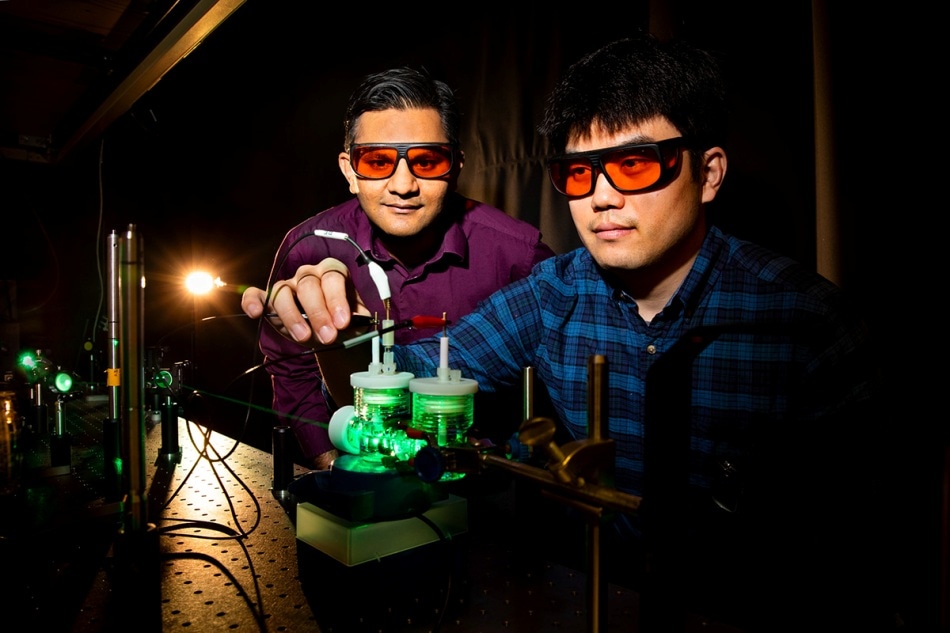May 23 2019
Chemists from the University of Illinois have been successful in producing fuels using carbon dioxide, water, and visible light by artificial photosynthesis.
 Jain, left, and Yu performing artificial photosynthesis experiments using green light. (Image credit: Fred Zwicky)
Jain, left, and Yu performing artificial photosynthesis experiments using green light. (Image credit: Fred Zwicky)
The conversion of carbon dioxide into more complex molecules such as propane has now taken green energy technology closer to the use of additional CO2 to store solar energy—in the form of chemical bonds—for use when there is no sunshine and during peak demand.
Plants use sunlight to steer chemical reactions between CO2 and water to produce and store solar energy in the form of energy-dense glucose. As part of the new study, the scientists created an artificial process that can use the same green light portion of the visible light spectrum used by plants during natural photosynthesis to transform water and CO2 into fuel, combined with electron-rich gold nanoparticles acting as a catalyst. The outcomes of the new study have been published in Nature Communications.
The goal here is to produce complex, liquefiable hydrocarbons from excess CO2 and other sustainable resources such as sunlight. Liquid fuels are ideal because they are easier, safer and more economical to transport than gas and, because they are made from long-chain molecules, contain more bonds—meaning they pack energy more densely.
Prashant Jain, Chemistry Professor, University of Illinois
He is also the coauthor of the study.
In Jain’s laboratory, Sungju Yu, first author of the study and a postdoctoral researcher, used metal catalysts for the absorption of green light and transfer of protons and electrons required for the chemical reactions between water and CO2—performing the role of the pigment chlorophyll in the natural photosynthesis.
According to Jain, gold nanoparticles, in particular, perform well as a catalyst since their surfaces show great interaction with the molecules of CO2, have the potential to absorb light, and do not disintegrate or degrade like other metals that can easily become dull.
The energy stored in the hydrocarbon fuel bonds is released in many ways. Jain stated that, however, the simple conventional combustion method results in the production of more CO2—which is counterproductive to the understanding of collection and storage of solar energy in the first place.
There are other, more unconventional potential uses from the hydrocarbons created from this process. They could be used to power fuel cells for producing electrical current and voltage. There are labs across the world trying to figure out how the hydrocarbon-to-electricity conversion can be conducted efficiently.
Prashant Jain, Chemistry Professor, University of Illinois
Although the CO2-to-liquid fuel development might bring excitement to green energy technology, the scientists agree that Jain’s artificial photosynthesis process is not as efficient as it is in plants.
We need to learn how to tune the catalyst to increase the efficiency of the chemical reactions. Then we can start the hard work of determining how to go about scaling up the process. And, like any unconventional energy technology, there will be many economic feasibility questions to be answered, as well.
Prashant Jain, Chemistry Professor, University of Illinois
This work was supported by the Energy and Biosciences Institute through the EBI-Shell program.